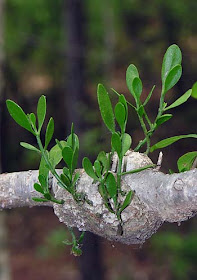The holiday plant we call
Mistletoe belongs to the family group called the
Santalaceae. Although there are over 250 species and 7 genera in the family group, the one we associate with the season is either the native European species
Viscum album or its similar American cousin,
Phoradendron leucarpum. Both are hemi, or half parasitic. They produce leaves and make their own food via photosynthesis, but rely on their host tree for their water needs and to supply nutrients, like nitrogen, potassium and phosphorus. Rather than roots, they produce structures that tap into a tree and steal the nutrients and water from the host. In fact, the name
Phoradendron is translated from Greek to "thief of the tree." The slow-growing plant forms a greenish-yellow evergreen shrub that grows two to three feet long, hanging from tree branches.
There are separate male and female plants, with only the female, naturally, producing the familiar white berries, from small, inconspicuous yellow flowers that bloom in the fall. Franklin County, PA is at the edge of the northern limit where mistletoe will naturally grow, since it is only hardy to zone 6a.
It is the larval host plant for the
Great Purple Hairstreak butterfly (
Atlides halesus), meaning the caterpillars eat the leaves of mistletoe, before pupating, undergoing metamorphosis, and emerging as an adult butterfly.
Most American mistletoe grown commercially for the decorating trade is harvested in Texas, Oklahoma, and New Mexico. In the forestry and lumber industries, mistletoe can be
considered a pest, or weed to be managed because of its detrimental effect on the host.
So how did mistletoe become a benign symbol of love and greeting, associated with the holiday season?
Dr. Leonard P. Perry, Extension Professor at the University of Vermont provides some possible answers.
Historically, in pre-Christian Europe, mistletoe was considered a religious symbol to pagan Druids. It grew, seemingly spontaneously, in the sacred oak tree, home to Druid gods. The superstition to
“knock on wood” to bring good luck, or ward off evil spirits, has its origins in this ancient belief. These ancient people believed mistletoe could cure diseases, make animals and humans more fertile, provide protection from witches, and bring good luck. In fact, mistletoe was so sacred to the Druids that if two enemies met beneath a tree where it was growing, they would lay down their weapons, exchange greetings, and observe a truce until the following day.
In
Scandinavian mythology, a dart made from the wood of mistletoe killed the god of peace, Balder. Balder was so beloved, that the goddess Frigg, wife of the chief god Odin, exacted an oath from the elements, earth, fire and water, and all manner of plants and animals that they would not harm him. At assemblies, lesser gods, giants and other inhabitants of the home of the gods would test the oath, and watch as weapons made from these elements were thrown at Balder, who would always escape unharmed. This did not set well with Loki, the god of mischief. Loki learned that alone among plants, the mistletoe had not been asked to swear to the oath. He fashioned a dart from the wood, and tricked a blind giant to throw it at Balder. It pierced his heart and killed him. His life was restored at the request of the other gods and goddesses, and the mistletoe was given to the goddess of love to prevent such a thing from happening again. She declared anyone passing under it should receive a kiss to show this plant was a symbol of love, and not of hate.
The early pagan converts to Christianity retained the mistletoe’s honored reputation, creating a legend that the cross was made from the wood of the mistletoe.
Today, researchers in Europe are investigating its medicinal properties as a possible treatment for cancer, although the jury is still out, and authorities disagree on the benefits. The berries are
considered toxic to pets and livestock, but birds are immune, and are the chief means of
seed dispersal. The toxicity to humans is in dispute, but prudence dictates that cautions should be taken around young children if using the plant in holiday decorations.
Thanks to
Tina Clinefelter, a Master Gardener in Clinton County and contributor to the
Gardening in the Keystone State blog for
piquing my interest to research
mistletoe as a subject for next week's news column, and this blog post.
Update: February 8, 2013. Roman, in the comments section, makes an excellent point. The European species,
Viscum album, is much
more toxic than its American cousin. I should have made that clear. Also, the use of Mistletoe extracts in European countries, is not an approved therapy by the US Food and Drug Administration (FDA), for cancer or any other medical condition. Details
here and
here.

